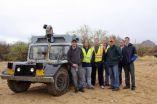(Press-News.org) TUCSON, Ariz. (June 2, 2011) -- In just 10 weeks, a group of University of Arizona engineering students took five crates of surplus hardware and two heavy-duty test vehicles, which didn't run, and mixed them with youthful enthusiasm, tenacity and many long hours to build two robotic vehicles that successfully drove themselves around UA's test mine.
It was no easy task, and predicted by some as too big a project for a one semester course: ENGR 450/550, autonomous vehicle systems. But the naysayers didn't factor in the can-do attitude of 23 undergraduate and graduate students who were willing to put in late nights following regular classes and daytime jobs.
The autonomous vehicles, which replace human drivers with computer control, satellite navigation and robotic vision, were originally part of a research program at Freeport-McMoRan in Safford, Ariz.
"Their mine technology group has been pursuing autonomous vehicle programs, and they asked if we could use some of the equipment they finished testing in 2008," said Mary Poulton, director of the Lowell Institute for Mineral Resources, which worked with Freeport-McMoRan to set up the equipment donation to UA. IMR is collaborating with the Science Foundation of Arizona, the mining industry and Arizona's universities to build a global center of mining excellence.
Tucson Embedded Systems stepped in and offered space to house the equipment and a place for students to work. Then it was simply a matter of loading five crates of hardware and two 7,500-pound vehicles onto a semi and transporting them to Tucson.
"The vehicles had been sitting for two years, and didn't start or run," said Sean Martinez, a systems engineering master's student and teaching assistant for the autonomous vehicle systems course. "The communications equipment was inoperable. None of the control software was correct for what we were doing. The hardware was all there, but nothing worked." And some important things were missing, such as a complete wiring diagram for the vehicles.
To sort this out, the course combined students from electrical and computer engineering, systems and industrial engineering, and aerospace and mechanical engineering -- teaming students in training to do everything from auto mechanics to software engineering to control systems fabrication.
"The next goal will be integrating a robot operating system and securing industry partnerships or research funding to fully exploit the research possibilities," Martinez said.
Poulton agrees. "When you have these kinds of test platforms, it's almost that the sky is the limit as far as what we can do with them now." Some mining companies already are using autonomous vehicles and the industry trend is in this direction, she added. Autonomous vehicles can work in remote areas or in underground mines where temperatures approach boiling and are too extreme for human workers.
Autonomous vehicles also are upgrading the skill set for mine workers. Instead of truck drivers, mining companies now need engineers who are familiar with autonomous systems. The two new autonomous vehicles built in ENGR 450/550 can give UA students that kind of experience.
It was a project that never would have happened without close industry support, first from Freeport-McMoRan, which donated the hardware, and then Tucson Embedded Systems (TES), which provided space and other resources. Autonomous Solutions Inc. also donated manuals for their software, and the college's Department of Systems and Industrial Engineering hired one of the company's partners to spend a couple of days in Tucson to get the students over some rough spots.
TES develops, designs and manufactures a variety of information technology software products for the aerospace, defense and commercial industries. The company specializes in systems design, development, integration and testing of hardware and software systems, and has worked closely with UA College of Engineering on projects in the past, such as the 2007 DARPA Urban Challenge, which called on engineering teams to build an autonomous vehicle that could drive itself through 60 miles of urban traffic.
In 2010, the TES-sponsored team won the best overall engineering design award at UA's annual Engineering Design Day competition. They built a robotic vehicle that could drive itself point-to-point using GPS navigation while avoiding obstacles. This year's senior design team extended that project by modifying the vehicle to deploy a series of sensors that measure temperature, humidity and sound. These sensors then were linked together in a network. The team also wrote network protocols to allow another group of students to communicate with and drive the robots, and built an android application to go on cell phones.
This application now can be applied to the full-size autonomous mine vehicles.
INFORMATION:
Media contacts
Pete Brown, UA College of Engineering Communications
520-621-3754
pnb@email.arizona.edu
Steve Delgado, UA College of Engineering Communications
520-621-2815
sdelgado@engr.arizona.edu
Robotic mine vehicles successfully reanimated by UA engineering students using industry support
2011-06-03
ELSE PRESS RELEASES FROM THIS DATE:
Mega Wins at Sun Vegas Casino
2011-06-03
2 players have struck it lucky at Sun Vegas Internet Casino on Monday the 30th May 2011. JK won CAD 23,373.50 playing on the video slot game Thunderstruck; CAD 21,453.50 on the 5-reel slot, Ladies Nite; and CAD 9,995.00 on the Egyptian-themed game, ISIS. Thus JK walked away with total winnings of CAD 54,822.00. Another winner, NJ, won $16,187.40 on Break Da Bank Again and $5,868.00 on Mega Moolah Summertime Progressive, giving her a total of $22,055.40.
Casino Manager at Sun Vegas Casino, Austin Green, said, "Two winners in one day is what makes Sun Vegas Casino ...
Scientists identify mutations that cause congenital cataracts
2011-06-03
New research identifies genetic mutations that cause an inherited form of cataracts in humans. The study, published online June 2 by Cell Press in the American Journal of Genetics, provides new insight into the understanding of lens transparency and the development of cataracts in humans.
A cataract is a clouding of the crystalline lens in the eye. Opacity of the normally transparent lens obstructs the passage of light into the eye and can lead to blindness. Congenital cataracts (CCs) are a significant cause of vision loss worldwide and underlie about one-third of the ...
For stressed bees, the glass is half empty
2011-06-03
When people are depressed or anxious, they are much more likely to see their glass as half empty than half full. In tough times, evidence of that same pessimistic outlook can be seen in dogs, rats, and birds. Now, researchers reporting online on June 2 in Current Biology, a Cell Press publication, show that bees, too, share those very same hallmarks of negative emotion.
"We have shown that the emotional responses of bees to an aversive event are more similar to those of humans than previously thought," said Geraldine Wright of Newcastle University. "Bees stressed by a ...
Fraser Yachts Review of the First Quarter 2011
2011-06-03
Following a spate of bookings during the last month, things are certainly looking rosier in terms of luxury yacht charter and the news regarding luxury yacht sales is similarly encouraging with an increase in numbers compared to the same period last year. Unfortunately the majority of these sales have been in the 24-35m categories, which represents the smaller end of the market, so while the volume is up the overall value of the market is somewhat down.
Fortunately, however, over the last few days' negotiations have been completed with regard to a number of very large ...
Gladstone scientists discover drug candidate for Alzheimer's, Huntington's disease
2011-06-03
SAN FRANCISCO, CA—June 2, 2011—Scientists at the Gladstone Institutes have identified a drug candidate that diminishes the effects of both Alzheimer's disease and Huntington's disease in animal models, offering new hope for patients who currently lack any medications to halt the progression of these two debilitating illnesses.
Gladstone Investigator Paul Muchowski, PhD, has identified a new compound called JM6 in experiments done in collaboration with an international team of researchers, and which are being published today in an online article in Cell. In laboratory ...
C-reactive protein levels predict breast cancer survival rates
2011-06-03
Levels of C-reactive protein (CRP) are increased in response to acute inflammation, infection and tissue damage. There are also reports that CRP levels are elevated because of cancer. New research published in BioMed Central's open access journal Breast Cancer Research shows that elevated CRP levels are predictive of a poor prognosis for breast cancer sufferers.
C-reactive protein is produced by the liver, in response to infection or injury, when stimulated by the cytokine IL-6. Tumor sites are often associated with inflammation and this inflammation contributes to tumor ...
Stem cell treatment to prevent leukemia returning is a step closer, say scientists
2011-06-03
Researchers at King's College London have identified a way of eliminating leukaemic stem cells, which could lead to new treatments that may enable complete remission for leukaemia patients. An early study in mice has shown that leukaemic stem cells can be abolished by suppressing two proteins found in the body.
Leukaemic stem cells sustain the disease and are likely to be responsible for relapse, so elimination of these cells is believed to be key for achieving complete remission. These encouraging findings highlight the two proteins as potential therapeutic targets ...
Revamped college science course improves student performance -- in spite of cuts
2011-06-03
Students overall performed better – and educationally disadvantaged students generally made even greater strides than everyone else – in an introductory biology course at a university where recent budget woes doubled class sizes for the course, cut lab times and reduced the number of graduate teaching assistants.
The keys to success are instructors who guide learning rather than lecture, and who structure courses so students are more likely to come to class having read assignments and where they undergo intensive practice to develop critical thinking and problem solving ...
Researchers characterize epigenetic fingerprint of 1,628 people
2011-06-03
Until a decade, it was believed that differences between people were due solely to the existence of genetic changes, which are alterations in the sequence of our genes. The discoveries made during these last ten years show that beings with the same genetics like the twins and cloned animals may have different characteristics and disease due to epigenetic changes.
Epigenetics involves chemical signatures that are added to DNA and proteins that package it, to regulate their activity. The more recognized epigenetic brand is DNA methylation, a process based on the addition ...
Non-independent mutations present new path to evolutionary success
2011-06-03
Mutations of DNA that lead to one base being replaced by another don't have to happen as single, independent events in humans and other eukaryotes, a group of Indiana University Bloomington biologists has learned after surveying several creatures' genomes.
And, the scientists argue, if "point mutations" can happen in twos, threes -- even nines – large evolutionary jumps are possible, especially when problems caused by a single point mutation are immediately compensated for by a second or third. The work appears in the latest issue of Current Biology.
"A similar phenomenon ...


